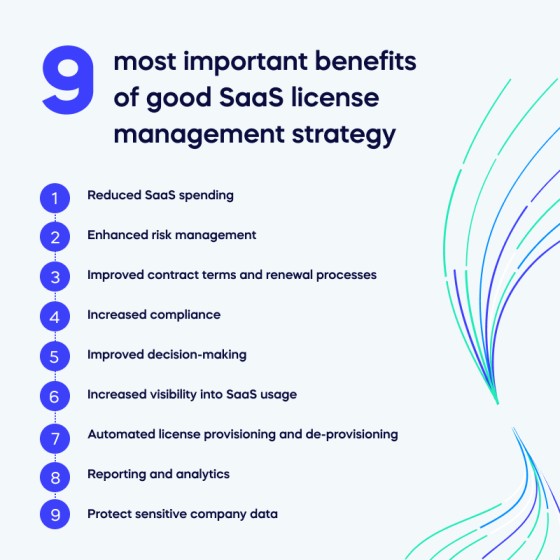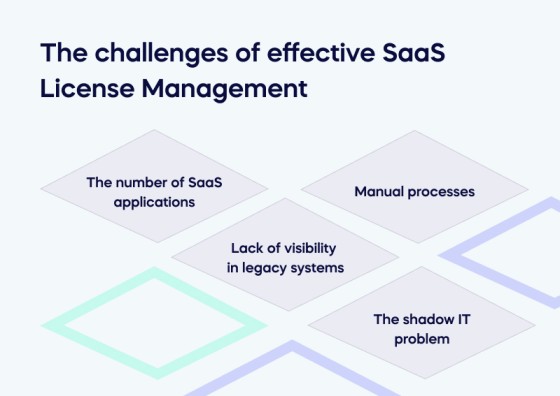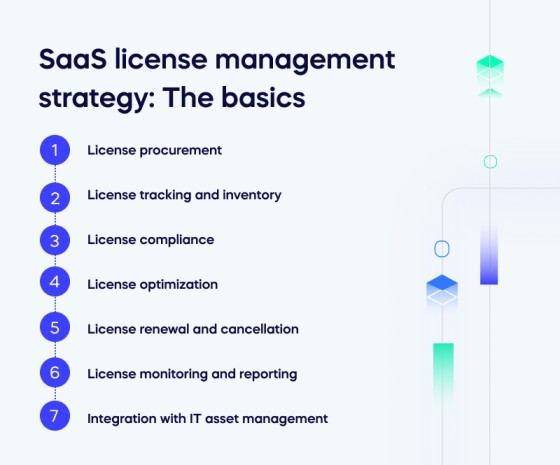Over the past twenty years, Software as a Service (SaaS) management has gradually become the main way software vendors monetize their products. Gone are the dates of a one-off upfront payment. In its place, we have the complex world of SaaS licensing.
Although internal software management was always an important discipline, the demands of SaaS license management require specific managerial interventions. Even a tiny company will have multiple saas licenses. So one way or another, businesses of every size have got to figure out how to keep track of their enterprise software spending.
To help with the challenges of SaaS management, this article will explain how to manage your SaaS solutions effectively. Here’s how we’ll do it:
- To start, the article will go over a full definition of what SaaS License management is, including why you need licenses, how they work, and who is responsible for them
- Then, it will explain the top benefits of SaaS Licence management, along with the key challenges
- We’ll then suggest some key steps for managing SaaS licenses in your company.
As we’ll see along the way, effective SaaS License management is very important for operational efficiency. One of the best SaaS management platforms is a more general Digital Adoption Platform – a form of software now reaching maturity in the marketplace. DAPs are so useful for SaaS apps that we will include a little note at the end.
What is SaaS license management?
SaaS License Management refers to organizations’ processes, practices, and tools to effectively manage and optimize their software-as-a-service (SaaS) licenses. It involves the planning, tracking, and monitoring SaaS licenses throughout their lifecycle, from procurement to retirement.
SaaS License management is a smaller niche of general Software Asset Management (or IT asset management), which covers all of the software in a company – whether or not it runs on a subscription.
Why do you need SaaS licenses?
SaaS licenses are a vital part of software services today. But it wasn’t always like that.
In February 2000, Salesforce ran a marketing campaign announcing the “end of software.” It was part joke, part truth, part prophecy. Up to the 1990s, buying software meant on-premises software installations, with their high upfront costs, complex deployments, maintenance requirements, and lengthy upgrade cycles.
Instead of “software,” we now have cloud-based SaaS – where every software user operates by subscription, no up-front payment. It’s a win for vendors, who can charge for access any way they want. And often, it can work well for customers who need much less commitment to a product or service. But like it or not, SaaS is here to stay – by 2024, the SaaS market size could be as much as $232 billion, up from a mere $32 billion in 2015.
How does a SaaS license work?
Before a piece of software goes to market, the developers sit down and think about how to monetize their product. They reflect carefully on how customers use the software and how to value the separate parts.
As a result, there is no “one way” to license a SaaS product. Some of the types of SaaS licenses include:
- User-based
- Concurrent
- Feature-based
- Storage-based
- Bandwith-based
- Time-based
- Module-based
- Enterprise-wide
- Pay-per-use
- Freemium
Today, any digitally-driven company can expect to use many different types of licenses. So it’s no surprise that software license management has emerged as an important managerial discipline.
Who is responsible for SaaS License management?
The person responsible for managing the company’s SaaS licenses will vary depending on the size and structure of the business. In small companies, the responsibility for SaaS license management may fall to the IT manager or another IT professional. In larger firms, a dedicated team may be responsible for SaaS license management.
Here are some of the roles within a business that may be responsible for managing SaaS licenses:
- IT manager. The IT manager is responsible for the overall IT infrastructure of the business, including the software licenses. The IT manager may be solely accountable for SaaS license management in small companies.
- Software asset manager (SAM). A SAM manages all software assets in a business, including SaaS licenses. SAMs typically have a deep understanding of software licensing and can help businesses to optimize their SaaS spend and ensure compliance with regulations.
- Finance department. The finance department tracks the company’s spending, including SaaS licenses. The finance department can help businesses to identify unused licenses and negotiate better contract terms with vendors.
- Compliance officer. Security and compliance issues are just areas that matter for license management. As a result, compliance managers have a key role to play in SaaS products. The compliance officer ensures the business complies with all applicable laws and regulations. The compliance officer can help companies track their usage of cloud-based software and ensure they comply with all applicable laws and regulations.
Ultimately, the person responsible for managing the company’s SaaS licenses will vary depending on the business’s specific needs. However, the abovementioned roles are some of the most common ones responsible for SaaS license management.
The nine most important benefits of good SaaS license management strategy

If you’re not already managing your SaaS licenses, now is the time to start. It’s one of the best ways to protect your business and save money.
Even though this feels like an “extra,” it’s fundamental to your company’s digital ecosystem. In this section, we’ll briefly introduce some of the top reasons for managing your SaaS licenses – including reducing your spending, improving risk management, and ensuring compliance at every step of the way.
Reduced SaaS spending
By tracking and managing SaaS licenses, businesses can identify areas of overlapping spend or eliminate inactive user licenses. This can help to reduce SaaS costs by up to 30%.
Enhanced risk management
SaaS license management can help reduce SaaS security risk by monitoring software utilization and ensuring that only authorized users can access SaaS applications. This can help to protect businesses from data breaches and other security incidents.
Improved contract terms and renewal processes
By clearly understanding their SaaS spend, businesses are better positioned to negotiate favorable contract terms and renewal rates with SaaS vendors. This can save companies money in the long run.
Increased compliance
SaaS license management can help businesses to ensure compliance with software licensing regulations. This can help to protect businesses from fines and penalties.
Improved decision-making
By accessing real-time data on SaaS usage, businesses can make better decisions about which SaaS applications to purchase, renew, or cancel. This can help businesses to optimize their SaaS spend and get the most value from their SaaS investments.
Increased visibility into SaaS usage
SaaS license management software can provide businesses with a single view of all their SaaS licenses, including the number of licenses purchased, the users assigned to each license, and the amount of usage each license gets. This information can be used to identify areas of overspending, unused licenses, and potential security risks.
Automated license provisioning and de-provisioning
SaaS license management software can automate the process of provisioning and de-provisioning licenses. This can help to ensure that users only have access to the licenses they need and that licenses are not wasted on inactive users.
Reporting and analytics
SaaS license management software can generate reports and analytics on SaaS usage. This information can be used to track trends, identify areas for improvement, and make better decisions about SaaS investments.
Protect sensitive company data
SaaS license management can help protect sensitive company data by ensuring that only authorized users can access it. For example, SaaS license management software can restrict access to SaaS applications based on user roles or permissions. Analysts confirm that a good licensing agreement can be foundational to cybersecurity.
The challenges of effective SaaS License Management

So, there’s no doubt that managing SaaS Licenses is a pivotal part of your organization’s overall IT strategy. However, it can be a complex and challenging task. As we’ve already seen, SaaS applications might run on completely different payment plans, but this is just one of the challenges software asset management professionals face. Let’s take a closer look at some of the challenges.
The number of SaaS applications
The number of SaaS applications in use by businesses is growing rapidly – often resulting in “digital friction.” This makes it difficult to keep track of all the licenses in use and ensure that they are being used correctly.
Lack of visibility in legacy systems
A dynamic SaaS license manager will closely monitor all the software acquisitions in their company. But in many cases, many SaaS licenses could have been acquired and maintained without due care. This lack of visibility into the use of SaaS licenses makes it difficult to identify unused licenses or track usage changes.
Manual processes
SaaS license management can be a manual and time-consuming process. This can make it difficult to keep up with the changes in licensing requirements and to ensure that licenses are being used efficiently.
The shadow IT problem
Shadow IT – sometimes known as Rogue IT – is the use of IT resources without the knowledge or approval of IT. This can make it difficult to track the use of SaaS licenses and to ensure that licenses are being used in compliance with organizational policies.
SaaS license management strategy: The basics

Perhaps you’ve decided that you will need some kind of help with managing your software assets. Where do you start?
Whether starting from scratch or re-thinking your company’s approach, it’s important to be strategic, not reactive. This section will briefly introduce key elements of software management strategy – from procurement to compliance to monitoring and evaluation.
When faced with the inefficiencies and complexities of a legacy SaaS stack, it may feel difficult to imagine going back to basics: but there’s no better way to achieve value from your Saas spend.
License procurement
This involves acquiring SaaS licenses, negotiating contracts, and evaluating licensing models to meet the organization’s needs. When procuring SaaS licenses, businesses should consider the type of application, the number of users, the features required, and the budget.
License tracking and inventory
This involves maintaining an up-to-date inventory of all SaaS licenses, including license types, quantities, expiration dates, and associated costs. Businesses should track their SaaS licenses to ensure that they comply with the licensing agreements’ terms and identify optimization opportunities.
License compliance
With compliance, you ensure that the organization complies with the terms and conditions specified in the licensing agreements. Licensing agreements typically specify usage restrictions, user limits, and license transferability. Businesses should monitor their SaaS usage to ensure they comply with the terms of the licensing agreements. Otherwise, they risk falling into trouble.
License optimization
Optimization supports the most efficient cost models for SaaS. In this process, the SaaS managers analyze license usage data to identify opportunities for optimization. For example, businesses can reallocate licenses from underutilized applications to high-demand areas, eliminate duplicate licenses, or downsize licenses based on actual usage. One of the best ways to monitor licensing data is through a digital adoption platform.
License renewal and cancellation
This involves managing the renewal process to avoid unnecessary costs or disruptions and handling the cancellation or retirement of licenses when they are no longer needed. Businesses should renew their SaaS licenses in a timely manner to avoid service disruptions.
License monitoring and reporting
This involves monitoring license usage and generating reports to track compliance, identify potential violations, and make data-driven decisions regarding license allocation and optimization. Businesses should monitor their SaaS usage regularly to identify potential license violations and make informed decisions about license allocation.
Integration with IT asset management
This involves integrating SaaS license management with broader IT asset management practices to have a holistic view of software assets, track dependencies, and ensure efficient utilization of resources. By integrating SaaS license management with IT asset management, businesses can better understand their software assets and make better decisions about allocating and optimizing their resources.
SaaS License Managenent with a Digital Adoption Platform
Within your strategy, there are plenty of ways to maximize your management techniques: whether that’s through tracking license data, making regular reviews of your licenses, or giving your staff dedicated training on licensing.
However, one tool stands out for many companies: the digital adoption platform.
Digital adoption platforms like WalkMe started as training tools for new software. Today, they still offer great training solutions. But they also give extremely detailed data about how staff use software products.
DAPs take the pain out of monitoring license use. With real-time dashboards showing you which software has plenty of active users and which are redundant tools, you can make well-informed decisions about your company’s software investments.
SaaS Licence Management: Getting it right
SaaS license management is a critical task for businesses of all sizes. Companies can reduce costs, improve security, and ensure compliance by managing their SaaS licenses effectively.
The challenges of SaaS subscriptions may get worse before they get better. After all, analysts predict that SaaS spending will accelerate across many types of software – including infrastructure services, security, and more. Now is a great time to implement cloud-specific licensing monitoring across your SaaS portfolio.
In this article, we’ve given you a quick introduction to how you can achieve this. We’ve seen how today’s cloud-based applications increase the demand for complex subscriptions – with numerous benefits to end users.
The article also explained how managing those subscriptions can be an important value source. If you know and understand the challenges, you will be well-placed to embrace the solutions, including a digital adoption platform.


